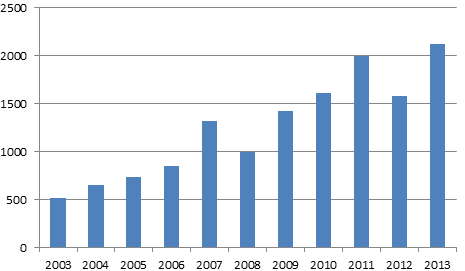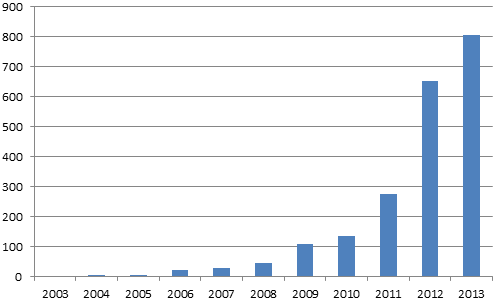 Extreme weather in the UK and abroad is increasingly described by the media as the ‘new normal’. Rather than discussing future and distant climate predictions, this terminology recasts climate change as something happening right now, and no longer treated as hypothetical. However, the link between extreme weather and climate change is rarely made explicitly in media coverage of events such as the current UK floods, writes Brigitte Nerlich.
Extreme weather in the UK and abroad is increasingly described by the media as the ‘new normal’. Rather than discussing future and distant climate predictions, this terminology recasts climate change as something happening right now, and no longer treated as hypothetical. However, the link between extreme weather and climate change is rarely made explicitly in media coverage of events such as the current UK floods, writes Brigitte Nerlich.
I am not a scientist. I am a media analyst of sorts. I therefore cannot check the veracity of scientific statements that establish (or not) a link between climate change and an increase in frequency of extreme weather events or scientific statements that dispute such a link. I also find it difficult to assess what climate is, or should be, regarded as normal, by whom and on what basis. What I can do is observe the way that an issue or problem is discussed in the public sphere, taking press coverage as a proxy. The emerging topic of extreme weather as ‘the new normal’ in the context of climate change is an issue of public debate that I’ll tackle today.
In the past, (relatively rare and sensational) extreme weather events, such as floods, droughts, heat waves, storms and so on, were used to convince people of the reality of and threats posed by climate, and, of course to sell newspapers. Such images were, to some extent, more symbolic than real, such as the flooding of Cologne cathedral on the front page of Der Spiegel in 1986. This fictional image was a symbol of the perceived dangers of future climate change, or as people called it in Germany, the impending Klimakatastrophe. This image has, for some, become a symbol of climate alarmism or catastrophism. Things may be changing though, as in 2013 German newspapers contained pictures of real churches and cathedrals, submerged for real, in the context of devastating floods in Southern Germany. Currently the UK is experiencing an extreme flood event which is affecting large parts of Western and Southern England, Wales and Cornwall. Here too images of churches and cathedrals submerged by waves or surrounded by floods are becoming commonplace.

Over the past decade media coverage of extreme whether has been increasing (see figure 1 below), while at the same time media coverage of climate change has been decreasing. Alongside this mismatch, the link between extreme weather and climate change has not been made in the media until quite recently, as Mat Hope pointed out in a his media analysis “Linking UK floods and climate change: A discussion notable by its absence?” This is partially due to climate scientists being very cautious about directly attributing any particular extreme event to climate change.
However, things may be changing. The UK Met Office has recently stuck its neck out and said that it was quite likely that climate change contributed to recent flooding and that it was even more likely that it would do so in the future. Things were still quite different last year at a meeting arranged by the Met Office to talk about a series of extreme weather events in the UK in 2013. In this context, the climatologist Professor Sir Brian Hoskins said on the BBC Radio 4 Today programme that ‘Quite honestly we don’t know’ what has caused strange weather patterns in past decade (18 June, 2013).
Extreme weather is of course more than floods: it also refers to extreme droughts, extreme blizzards and wild fires, all happening somewhere in the world at this very moment. These increasingly frequent and dramatic events seem to be changing public opinion in United States for example, and the same may be the case here in the UK. Anthony Leiserowitz, director of the Yale Project on Climate Change Communication, pointed out that Americans are beginning to “connect the dots between climate change and extreme weather“. As one science writer, Andrew Freedman, said “all weather seems suspicious now“.
So, while climate change may still be out of the news, extreme weather is increasingly discussed in the news. And slowly links between the two are being established and discussed.
A flood of reporting
As the following figure shows, the phrase “extreme weather” is gaining prominence in English media discourses (other frequently used terms such as odd, weird, strange, bizarre, freak, severe, unprecedented or unusual weather are excluded). English language news reporting on ‘extreme weather’ has increased quite steadily since 1988, when climate change became an issue of public concern. But it has been also continued to rise after 2007, the year that interest in climate change began to fall. This increase in extreme weather reporting might make it difficult to keep extreme weather discussions separate from discussions about climate change in the future. One indication of this happening is an observable growth in use of the phrase ‘the new normal’ (see figure 2), which has also been used to report on the current UK winter floods.

The new normal
The phrase ‘the new normal’ has been used by economists to describe the aftermath of the recession. The phrase also occurs in the context of a television series about a gay couple going through the adoption process using a surrogate mother, where redefining the family unit has become the new normal. As early as 2002 the phrase was used in 2002 in the context of discussing a drought in Texas, and I would guess there are earlier attestations that I have not found yet.
A search of ‘All English language news’ publications through Nexis® using the keywords ‘new normal’ and ‘climate change’ revealed that the following paragraph is the earliest use of the phrase in relation to climate change (I have left out paragraph breaks):
What if we tell our grandchildren about a time when Colorado had forests, mountains covered with snow, rivers full of fish, enough water to irrigate even the worthless grass along hundreds of miles of highways – and they think we’re demented? What if this drought of ’02 is the new normal? ‘It’s very hard to say what the cause of any drought is,’ said Brian Toon, director of the Atmospheric and Oceanic Sciences program at the University of Colorado-Boulder, when I ask him if this desperately dry year is normal. He said it’s possible that it’s simply the cyclical nature of the weather. (The Denver Post, 16 June, 2002)
Two years later in 2004 the phrase appeared for the first time in the headline of an article dealing with disaster management. Since then the phrase has steadily grown in popularity in the media (see figure 2), with a peak around the end of 2012 and the beginning of 2013. This peak seems to be associated with describing extreme weather events like Hurricane Sandy as ‘the new normal’.

What are the reasons for the rise in popularity of this phrase? There are at least two competing explanations. Some may argue that ‘the new normal’ is a type alarmism, while others may argue that it is a signal for climate realism; that it is indeed indicative of a new climate reality in which extremes are becoming the norm.
Rather than discussing future and distant climate predictions, which people may be inherently sceptical of in any walk of life, the ‘new normal’ recasts climate change as something happening right now, and no longer treated as hypothetical. Extreme weather events happening here and now will reinforce public perception that what was once merely symbolic is now very real and indeed even normal.
All this is however still contested ground with some, like Climate Depot, arguing that ‘extreme weather events are ever present, and there is no evidence of systematic increases’, while others, like New Scientist, claiming that the “spate of extreme weather, then, is a snapshot of the not-too-distant future. Soon, this will be the new normal. We call events like the Australian heat wave ‘extreme weather’, but within the next few decades they will simply be ‘weather’”.
Note: This article gives the views of the author, and not the position of the British Politics and Policy blog, nor of the London School of Economics. Please read our comments policy before posting.
About the Author
 Brigitte Nerlich is Professor of Science, Language and Society in the Institute for Science and Society at The University of Nottingham. She is also Director of the Leverhulme research programme ‘Making Science Public‘ and PI on ESRC funded project devoted to charting climate change debates.
Brigitte Nerlich is Professor of Science, Language and Society in the Institute for Science and Society at The University of Nottingham. She is also Director of the Leverhulme research programme ‘Making Science Public‘ and PI on ESRC funded project devoted to charting climate change debates.






The debate has change a bit over the last week and climate change has become a bit more prominent in discussions of extreme weather, see here: http://www.carbonbrief.org/blog/2014/02/analysis-how-uk-newspapers-are-increasingly-talking-about-climate-change-and-flooding/
Whether this trend signifies a significant shift remains to be seen….